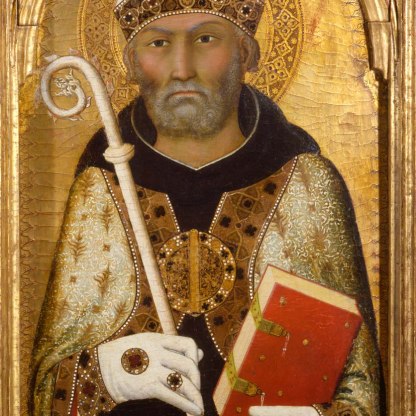Panels from an Altarpiece

'Simone must have been in Paradise, and studied well and copied what he saw ...' (Petrarch, Sonnet 76)
In an era when painters were usually anonymous artisans, craftsmen contracted by an individual patron or organisation, Simone Martini made a rare name for himself. Celebrated in his own lifetime in the sonnet by Petrarch quoted above, his influence upon European painting was felt long after his death. The successor to and possibly the pupil of Duccio, Simone travelled and worked far beyond the boundaries of his native Siena, eventually settling in the exiled papal court in Avignon.
The three superbly preserved panels in the Fitzwilliam were not originally arranged as they are now. They come from a pentaptych, a much larger altarpiece, consisting of five panels joined horizontally together. The remaining two are now in other European collections.
Between the figures of St Michael and St Augustine, there was originally a large central painting of the Virgin and Child. An image of St Catherine of Alexandria holding a book, a martyr’s palm and the wheel on which she was tortured, came between this and the panel showing St Geminianus. On the left is a reconstruction of how the original altarpiece might have looked.
The bishops, who both wear mitres and hold croziers and books, can be identified by painted inscriptions on strips at the bottom of the panels, now scarcely legible. Geminianus, detail left, is rarely depicted in art. A fourth-century martyr and bishop of Modena, he was the patron saint of San Gimignano, a town in Tuscany not far from Siena.
St Augustine, detail left, is a much more familiar figure. This great theologian and Father of the Church is identifiable here by the black habit he wears under his bishop’s cope. It is the same as that worn by members of the Augustinian order of friars, formed in the eleventh century, monks who derived the rules for their way of life from Augustine’s extensive writings. The large red book he holds in his left hand alludes to this important body of work. Right is an illumination from a fifteenth-century manuscript of Augustine's Confessions in the Fitzwilliam [MS.171.f.1r]. The saint kneels on the ground and gazes up at a vision of the Holy Trinity. A book and a bishop's mitre rests on a table beside him.
With these two figures firmly identified, we can be fairly certain that this altarpiece was commissioned for the church of San Agostino in the town of San Gimignano, celebrating as it does the town’s patron and the saint to whom the church is dedicated. It is thought to have been made around 1320.
In the painting we can see the hallmarks of Simone’s particular genius: the minute and splendid details, seen in particular in the bishops’ beards and the vine pattern on Geminianus' cope. Look at the brilliant variety of painted textures: the wings of the archangel, the richly brocaded hem of St Augustine’s cope compared with the black habit beneath. And then there are the rich, harmonious colours, the use of gold and the delicate patterns of punched holes which add lustre to the haloes of the saints.
Themes and periods
Data from our collections database
Thomas Blayds; his sale, Christie's, 30-31 March 1849 (181), as Gentile da Fabriano, bt. Anthony; Rev. J. Fuller Russell by 1854; his posthumous sale, Christie's, 18 April 1885 (101), as Sienese, bt. Charles Butler
Acquisition and important dates
- Method of acquisition: Bought
- Dates: 1893
Dating
- 14th Century, Early
- Production date: circa AD 1319
Maker(s)
- And workshop Martini, Simone Painter
Materials used in production
Read more about this recordStories, Contexts and Themes
Other highlight objects you might like
Suggested Curating Cambridge products
Sign up to our emails
Be the first to hear about our news, exhibitions, events and more…






